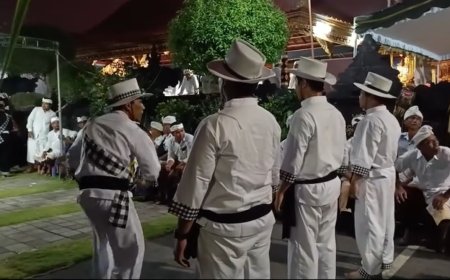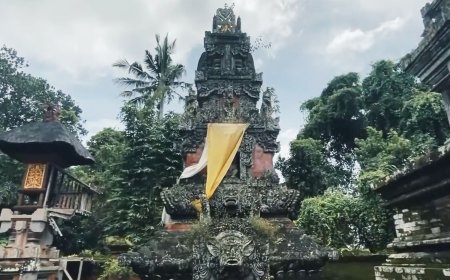Pura Panti Taman Sari, Karangasem: A Gateway of Communication with the Ancestors of Tegallingah Village, Karangasem
Pura Panti Taman Sari in Tegallingah Village, Karangasem, Bali, is a sacred site where the local community honors their ancestors. Believed to have been established after the Kingdom of Karangasem triumphed over Lombok in a historic war, this temple preserves a wealth of historical and spiritual significance, carefully maintained to this day.

Pura Panti Taman Sari is a temple located in Tegallingah Village, Karangasem District, Karangasem Regency, Bali. This temple serves as a sacred place for the people of Tegallingah Village to honor and revere their ancestors. Although the exact date of its establishment is unknown, many locals believe that the temple was built after the Kingdom of Karangasem triumphed over Lombok in the Karangasem-Lombok War. The temple holds a wealth of historical stories and sacred values that are still preserved to this day.
According to the elders of Tegallingah Village, Pura Panti Taman Sari was initially established by the village’s ancestors as a sacred place for the community to perform communal worship. At that time, the people of Tegallingah Village did not yet have a shared temple, as they only had individual family shrines or sanggah merajan at each of their homes. Therefore, the ancestors of Tegallingah Village built Pura Panti Taman Sari to provide a communal place of worship and to strengthen the spiritual ties within the village community.

Sanggah Pura Taman Sari(Source: Private Collection)
Pura Panti Taman Sari holds profound historical and spiritual significance for the people of Tegallingah Village. It serves not only as a center of worship but also as a silent witness to the historical and cultural journey of the village. During the time of the Kingdom of Karangasem, Tegallingah Village was a strategic location used for training and preparing the kingdom’s soldiers before they went to battle.
The village became a training ground where soldiers practiced combat skills by riding their horses around the village. After riding, they would tie their horses and equipment to frangipani trees in the village—one tree in the north (kaja) and the other in the south (kelod). The frangipani tree in the southern part is believed to possess mystical powers and is thought to grant wishes to those who pray near it with pure intentions. These two trees are often referred to as the “Twin Frangipani Trees.”
The mystery surrounding the existence of these frangipani trees has sparked debate among the people of Tegallingah Village. Some believe that the trees existed long before Pura Panti Taman Sari was built, while others believe the trees were planted when the temple was constructed. This debate continued for years until a historical inscription kept in the village was opened and studied by local historians. The inscription revealed that the frangipani trees had indeed grown there long before Pura Panti Taman Sari was established, and eventually, the temple was built around these sacred trees, marking the sanctity of the site.

Kelod Frangipani Tree (Source: Private Collection)
The people of Tegallingah Village carry out worship at Pura Panti Taman Sari on specific sacred days, known as piodalan, such as:
- Galungan
- Kuningan
- Purnama Sasih Kapat
- Buda Wage Kliwon
During the celebration of Purnama Sasih Kapat, village administrators have a special tradition of cleaning the inscription kept at Pura Panti Taman Sari. This inscription holds significant historical and spiritual value for the local community. Initially, the inscription was kept in the home of one of the original villagers as a symbol of the village's ancestral heritage. Eventually, the inscription was carefully wrapped and moved to Pura Panti Taman Sari, where the community could honor and preserve it as part of their cultural and spiritual heritage.

Galungan Celebration Atmosphere (Source: Private Collection)
Galungan, one of the biggest holy days for Hindus, is a special moment for the people of Tegallingah Village. On this sacred day, villagers gather at Pura Panti Taman Sari to perform communal prayers, creating a profound sense of togetherness and solemnity. The Galungan celebration not only provides an opportunity for collective prayer and gratitude but also serves as a form of respect for their ancestors who endeavored to establish Pura Panti Taman Sari.
Through this celebration, the people of Tegallingah Village appreciate and honor the noble intentions of their ancestors who built the temple as a place for the community to gather and worship. In the spirit of Galungan, Hindus in the village strengthen their spiritual bonds, uniting their hopes and prayers as a community bound by a shared history and cultural values passed down through generations. Pura Panti Taman Sari becomes the heart of the celebration, reminding them of the importance of togetherness in preserving and continuing their ancestral heritage.

Pura Taman Sari Inscription (Source: Private Collection)
The inscription tells the story of a man believed to be one of the first settlers of Tegallingah Village. According to the inscription, this man was the first to inhabit the area and later invited passersby to join him in settling there. Together, they built homes and formed the initial community of the village, laying the foundation for what would become Tegallingah Village as it is known today.
In addition to recounting the founding of the village, the inscription also details the lineage of the people of Tegallingah Village, making it an important historical resource that connects the current generation to their ancestors. The inscription not only depicts the origins of the village but also reflects the values of solidarity and mutual cooperation that form the foundation of village life. To this day, the inscription is revered as a symbol of the village's historical bonds and deep cultural identity.
As a symbol of history and ancestral heritage, Pura Panti Taman Sari continues to play an essential role in the spiritual and social lives of the people of Tegallingah Village. Through various traditions, such as worship on sacred piodalan days, the cleansing of the inscription during Purnama Sasih Kapat, and the Galungan celebration, this temple upholds the noble values passed down through generations. Pura Panti Taman Sari is not just a place of worship but also a reminder of togetherness, respect for ancestors, and pride in a rich cultural legacy. Through this temple, the people of Tegallingah Village inherit moral messages that connect them with the past, inspiring them to preserve and uphold a culture that has endured for centuries.






























































